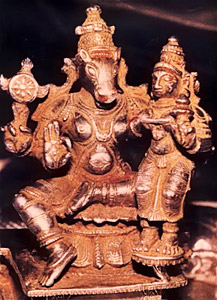Hayagrīva previous to Veṅkaṭanātha seems to have a non-specific Vaiṣṇava iconography, with only his horse-head as a fixed element. He is, for instance, a standing figure in Khajurao, where he carries a club and has one hand in the dānamūdrā.

Hayagrīva at Khajurao
By contrast, after Veṅkaṭanātha, the iconography radically changes and two possibilities become fixed:
Yoga Hayagrīva: seated in padmāsana, carrying conch and discus in the upper hands and the Vedic book in the lower left one. The lower right one displays the jñānamūdrā or the vitarkamūdrā, both linked with the bestowing of knowledge.
Lakṣmī Hayagrīva: seated in lalitāsana, carrying the same attributes, displaying the same gesture, together with Lakṣmī.

Veṅkaṭanātha describes in his Hayagrīvastrotra the first one of the two, whereas the second form might be due to the fact that according to the Śrī Vaiṣṇava theology Viṣṇu is always connected with Lakṣmī. I could not detect any iconographic form of Hayagrīva previous to Veṅkaṭanātha and conforming to his description, thus:
What was the source of Veṅkaṭanātha’s precise description?
Probably an early and little studied Pāñcarātra Saṃhitā, the Hayaśīrṣa Saṃhitā (Hayaśirṣa means “horse-headed”, just like Hayagrīva and Aśvaśiras), of which only the first book has been edited (you can find it on Scribd). This describes Hayagrīva at least twice. First, in the first chapter of the first book, it says:
With four arms, carrying the club, the discus, the lotus and the bow (first part of v. 22ab)
caturbhujaṃ gadācakrapadmaśārṅgadharaṃ […]
However, in the 25th paṭala ‘chapter’ of the first book, the Hayaśīrṣa Saṃhitā describes Hayagrīva in a form very similar to the one found in the Hayagrīvastotra:
Or, one should let [an artist] make me with conch, discus, club and Vedas in the hands || 24 ||
Distinguished as having the face of a horse and four arms |
seated in padmāsana and connected in the upper part of the body with the Goddess || 25 ||śaṅkhacakragadāvedapāṇiṃ vā kārayīta mām || 24 ||
aśvavaktraṃ caturbāhum evam eva vyavasthitam |
puṣkarāsanam adhyasthaṃ devīdvitayasaṃyuktaṃ || 25 ||
You will note that the two forms do not harmonise and that the first one seems more old-fashioned, insofar as it is closer to the pre-Veṅkaṭanātha iconography. The latter description, by contrast, is somehow intermediate between the Khajurao and the later ones, since it has too many attributes, so that it is at least possible to choose among them (whereas at later times the club is just forgotten). Furthermore, it is seated as in the Hayagrīvastotra, but connected to Lakṣmī. This shows that Veṅkaṭanātha probably had a precise model and that he chose to focus on what was according to him the real essence of Hayagrīva, with some specific attributes (I could imagine that the club was eliminated also because Veṅkaṭanātha wanted to be sure that the jñānamūdra and the Vedic book were always present) and without Lakṣmī.
I will discuss the iconography of Hayagrīva at the EAAA conference on Friday the 26th of September. You can read a preliminary draft of my presentation here. For another post on Hayagrīva, see here. I am grateful to Robert Leach and Marion Rastelli for discussing this issue with me.

Comments and discussions are welcome. Be sure you are making a point and contributing to the discussion.